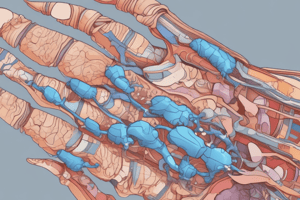Podcast
Questions and Answers
Which of the following are phases that drugs undergo? (Select all that apply)
Which of the following are phases that drugs undergo? (Select all that apply)
- Psychological phase
- Pharmacokinetic phase (correct)
- Pharmacodynamic phase (correct)
- Pharmaceutic phase (correct)
What is the purpose of the Pharmaceutic phase?
What is the purpose of the Pharmaceutic phase?
To reduce drugs in solid form into smaller particles and dissolve them into a liquid for absorption.
What processes does the Pharmacokinetic phase describe?
What processes does the Pharmacokinetic phase describe?
Drug absorption, distribution, metabolism, and excretion.
Which of these refers to the mechanism of drug action and its effects on the body?
Which of these refers to the mechanism of drug action and its effects on the body?
Match the following drug absorption routes with their characteristics:
Match the following drug absorption routes with their characteristics:
Drugs in liquid form are absorbed faster than solid drugs.
Drugs in liquid form are absorbed faster than solid drugs.
The process of drug _____ refers to the breakdown of a tablet into smaller particles.
The process of drug _____ refers to the breakdown of a tablet into smaller particles.
What does bioavailability refer to?
What does bioavailability refer to?
What is a loading dose?
What is a loading dose?
Which of the following factors does NOT affect drug absorption?
Which of the following factors does NOT affect drug absorption?
Flashcards are hidden until you start studying
Study Notes
Treatment Modalities
- Successful treatments often utilize a combination of drug therapy, diet therapy, physiotherapy, and psychological therapy.
- Drug therapy involves the use of medications to treat conditions.
- Diet therapy includes dietary restrictions to manage health.
- Physiotherapy employs techniques like light, water, and heat for healing.
- Psychological therapy addresses mental health issues and promotes emotional well-being.
General Principles of Drug Action
- Approximately 80% of medications are administered orally.
- Drug action occurs in four phases: pharmaceutic, pharmacokinetic, pharmacodynamic, and pharmacotherapeutic.
Pharmaceutic Phase
- Disintegration involves breaking down tablets into smaller particles.
- Dissolution occurs when these particles dissolve in gastrointestinal (GI) fluids for absorption.
Pharmacokinetic Phase
- This phase tracks drug movement through absorption, distribution, metabolism, and excretion.
- Movement is classified as:
- Absorption: Drug enters the bloodstream from the site of administration.
- Distribution: Drug is transported to various body tissues.
- Metabolism: Drug is chemically altered for excretion.
- Excretion: The drug is eliminated from the body.
Pharmacodynamics
- Focuses on how drugs affect the body and their mechanism of action.
Clinical Pharmacokinetic Considerations
- Onset of action: Time taken for therapeutic effects to begin.
- Drug half-life: Time to achieve maximum drug effect.
- Duration of effect: How long the drug's effects last.
- Metabolism refers to how the drug is transformed in the body.
- Excretion site influences drug removal.
Loading Dose
- An initial amount of drug administered to rapidly achieve therapeutic levels.
Absorption
- Refers to the process from drug introduction to entry into systemic circulation.
- Absorption pathways can include:
- GI tract (oral and rectal)
- Mucous membranes
- Skin
- Lungs
- Muscular and subcutaneous tissues
Mechanisms of Absorption
-
Passive Transport:
- Energy-free movement across membranes via diffusion.
- Diffusion: Higher to lower concentration.
- Facilitated Diffusion: Requires a carrier protein for movement.
-
Active Transport:
- Requires energy to move drugs against a concentration gradient with a carrier (enzyme or protein).
Factors Affecting Absorption
- Liquid drugs typically absorb faster than solids.
- Intramuscular (IM) injections are absorbed quicker in more vascular muscles like the deltoid than in less vascular areas like the gluteus maximus.
- Rectal administration absorbs slower than oral.
- Subcutaneous (SQ) absorption is slower than IM due to lower blood flow.
Other Influencing Factors
- Lipid/water solubility, stomach acidity, blood flow, pH levels, food presence, and stress can impact drug absorption.
- Bioavailability is the percentage of drug that reaches systemic circulation, influenced by drug form, route of administration, and liver metabolism.
Absorption Rates
- Fast-acting routes include sublingual, intravenous (IV), and inhalation for rapid therapeutic levels.
- Slower absorption occurs with oral, IM, and SQ routes due to complexities in the GI mucosal layers and other tissues.
- Increased blood flow at the absorption site enhances drug uptake and efficacy.
Impact of Pain and Stress
- Pain and stress can hinder absorption through:
- Altered blood flow.
- Reduced gastrointestinal movement.
- High-fat and solid foods can delay gastric emptying and subsequent drug absorption.
Studying That Suits You
Use AI to generate personalized quizzes and flashcards to suit your learning preferences.




